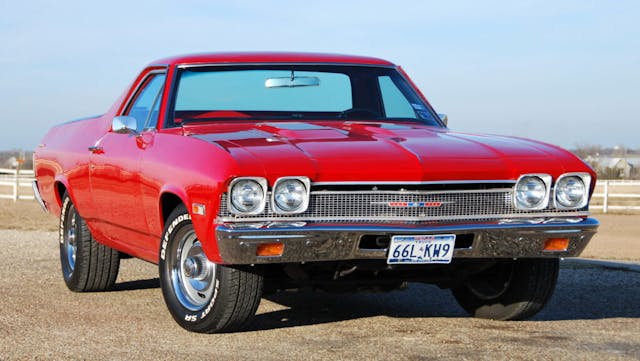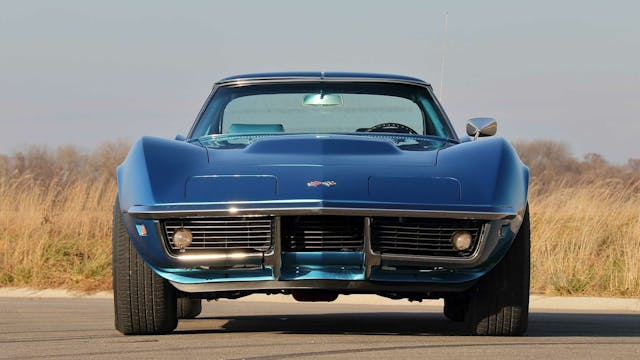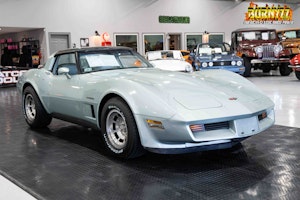Media | Articles
8 1960s Classics With Faces We Can’t Help but Love
We blame the weather. While the staff of this website calls many places in the United States (and overseas) home, the lion’s share of our editors are located somewhere in the Midwest. And right now, dear reader, the Midwest weather is volatile as hell.
Naturally, we turned to internal discussions about cars to cope with a week where temperatures fluctuated by as much as 50 degrees and weather patterns swung from rain to sun to snow and back again.
This time around, we got to talking about the ’60s, one of our hobby’s indisputable golden eras. That led to discussions about front-end design, and how radically different it was from automaker to automaker. In short order, many of us began campaigning for certain cars with front ends that stuck in our hearts and minds, for one reason or another.
Compiled here is a list of eight such cars. Beneath each nominee is a brief summary of why it warrants appreciation, made by each car’s loudest proponent in the (chat)room.
Rules? Delightfully few. The car had to be built at some point in the ’60s, and beyond that, it was up to each of us to make the case. Naturally, such a loose mission brief will have let many great cars slip through the cracks. Got one that should have made this list? Let fly in the comments below!
1968 Chevrolet El Camino

If your first thought was that the face of the ’68 ElCo is virtually the same as that of the Chevelle, allow our own Cameron Neveu to offer the most compelling—if a bit unorthodox—case for picking the former:
“Why the El Camino over the identical appearing 1968 Chevelle? Well, the ElCo front end looks even sweeter knowing you’ve got a bed out back.”
An open and shut case, in our eyes. The 1968 model’s four round headlights make it extra distinct, and while the performance fan in us enjoys the SS badge between those four eyes, there’s something about the long, horizontal Chevy emblem that we can’t resist.
Marketplace
Buy and sell classics with confidence
1968 Citroën DS

The DS pops up in all sorts of design lists, and for good reason. Those swooping body lines were quite brave for the era, and who could forget the high-tech hydraulic suspension that gave the car a magic carpet-like ride, helping to accentuate the design details that seemed to float over the blacktop? But the nose is worth celebrating on its own. As U.K. correspondent Nik Berg reminded us, if you sound out the DS title with a thick enough French accent, you’ll hear “Deésse,” which just happens to be French for “goddess.”
The big, wide headlights at either corner, contrasted with the waterfall of the hood in the middle, the exceedingly convex chrome bumper, and the lack of a grille make this front end as striking as they come.
1965 Buick Riviera

If the front end of a car were to be described as “very Teddy Roosevelt-esque,” could you picture it? In a single sentence, Eddy Eckart swayed the jury in his favor: “Simple, and formal in a means business kind of way, all without being too assertive.”
Gaze upon the forward cant of those headlamps; marvel at the buttresses flanking the massive hood. “The Riviera looks like a concept car that actually made it to production,” added Brandan Gillogly. There’s a reason this car is a popular choice for custom builders and restomod specialists, and it has everything to do with how the Riv’ manages to speak softly, while … well, you know the rest.
1966 Alfa Romeo Giulia Duetto Spider

If the Riviera is an American sledgehammer, Stefan Lombard nominated a delicate Italian pickaxe to contrast it. While it’s hard to find a bad angle of the Giulia Duetto Spider, the car’s clean, simple face manages to avoid the “mouth-agape fish” look that so many small cars of the time suffered from.
He also noted that while many cars look great from a front 3/4 angle, it can be harder to make the head-on view sing. In the Duetto’s case, Lombard had this to say: “The sloping nose and covered headlights lead into that delicate V grille, which flows back beneath the car. I love it.” Hard to argue with that!
1969 Chevrolet Corvette

The chrome front bumper the third-gen Corvette stuck around through 1972, but since the design debuted in 1968, it counts. Resident Corvette fanatic Grace Houghton opted to shout out the 1969 model, and we didn’t need any additional convincing. Two beautifully high fenders dip down to a broad chrome bar that spans the width of the car’s face. Below the bumper, two rectangular inlets, each housing a round turn signal bulb. The look, as Houghton so eloquently put it, “manages to look muscular and delicate at the same time … So Mako Shark, and so good.”
Bonus points if we’re looking at a ’69 L88, with its massive hood bulge shrouding a 427 big-block.
1969 Ford Mustang Mach 1

Though it’s easy to blur the lines, it bears repeating that “muscle cars” and “pony cars” were not always the same things. When it debuted in April of 1964, the Mustang was a relatively docile thing. The front end might be famous now, but that has more to do with what the Mustang has become in automotive culture than it does with how it looks on its own.
That look began to change almost immediately, as our resident Ford guru Sajeev Mehta reminded us. By 1969, the Mustang’s face had gone from cheerful companion to something far more sinister. As Mehta put it: “The 1969 Mustang took the hum-drum front end of the 1965 model and made it deeper, more aggressive, and far more angry. It became half muscle car and half pony car.”
1963 Studebaker Avanti

Though I’ll admit it’s not my favorite front end from the 1960s, there’s something distinctive and instantly recognizable about the Studebaker Avanti that warrants respect. Those perfectly round headlights seem like they should flank a broad grille, but instead, it’s just solid bodywork. That decision highlights the offset futuristic-script “Avanti” emblem that proudly proclaims the model’s identity. The fenders end in sharp corners, framing the simplicity of the grille-less countenance. You can’t help but appreciate designer Raymond Loewy’s flair for the dramatic.
“Counter-point, there should be a grille between this headlights and this nominee is actually bad.” – Stefan Lombard
Well, that’s just like, your opinion, man.
1968 Dodge Charger R/T

Fret not, Mopar fans, our site’s executive editor has you covered. Eric Weiner was swift and decisive with his nominee, the ’68 Charger. That broad, mail-slot rectangle of a grille is immediately recognizable. Hidden headlights add a menacing tone to the front end, and this is one of the few cars that makes a large front overhang look attractive.
This rectangular motif also carries over onto the new Dodge Charger. Anytime a front end’s design elements can look attractive in two distinctly different eras, you know you’ve got a winner in your hands.
***
Check out the Hagerty Media homepage so you don’t miss a single story, or better yet, bookmark it. To get our best stories delivered right to your inbox, subscribe to our newsletters.




















69 Impala and Caprice
I like the base ’67 Camaro, with the round parking lights/turn signals – classic elegance. Also have a look at an early Triumph TR4 front end as a fine example of doing it right.
These are all beautiful (well, except the Citroen which was underpowered and a rust bucket waiting to happen) but where is the king of all auto designs, the E Type Jaguar?
Swap out the Alfa. Replace with the XKE or the Muira. Every angle of these cars are stunning.
I agree! And I even own a later model of the Alfa.
……… or an Austin Healey
When it comes to Mustangs, and although having owed a ’68 Shelby GT350, I’ve always held in higher regard the styling of the ’69-’70 Shelby front ends.
And don’t forget the DS had rotating headlights, working with the steering wheel !
Im happy to see 2 of my personal cars are included in your list. Great minds think alike!
The smiling face of an Austin Healey 3000
Is always a welcome sight
Absolutely!
Agree with some of the selections, but if we’re focused on the 1960’s, knock the Citroen DS off – it’s an extremely modern & iconic, but 1950’s design. I’d also beg to differ with the El Camino – no way that makes a list of eight select iconic 1960’s front ends…and it’s the same as a base 1968 Chevelle four door sedan! For starters, I can’t believe you left out the following iconic front ends from the 1960’s…1967 Jaguar XKE, 1967 Mercury Cougar, 1966 Oldsmobile Toronado! There are arguably other more iconic 1960’s front ends than some that are on the list too – cases in point would be a 1962 Chrysler Imperial – ranging up to many different Ferrari’s – like the 250 LM, 250 GT Berlinetta Lusso, or beastly 275 GTB. And what about the Lamborghini Miura?!?
Ok, an Avanti over a ‘69 GTO? Don’t know why I follow these Email links.
I know! I know! It’s so you can come on here make your negative comment. Is that the right answer?
Jaguar XKE above all others!!
The 1960 Ford Falcon has kind of a unique presentation.
You put the Avanti on this list but left out the 67 Cougar?? Tsk, Tsk, Tsk!
67-69 T-bird has a great grill and tail. 2-fer…
’68 Camaro RS
Mustang, El Camino and Charger don’t even chart. Mustang excess. Chevy snore. Charger mail slot. Nothing clever or memorable in any of these.
Another vote for the 67 Cougar. Also: 66 Olds Toronado, 65 full size Pontiac, 61 Cadillac, 62 Studebaker Hawk, 69 Grand Prix, 68 AMC Javelin, 62 Plymouth, 60-61 Valiant, 67 full size Olds, 67 Eldorado, 67 Chrysler… so many better examples out there.